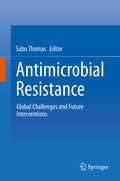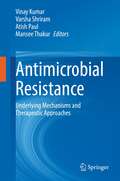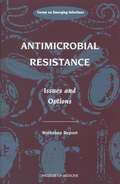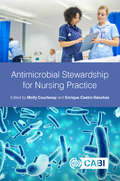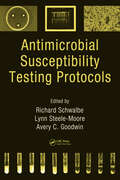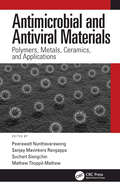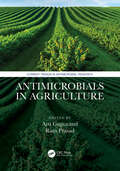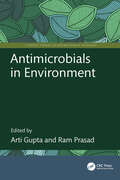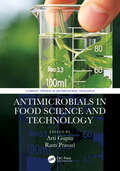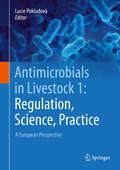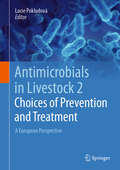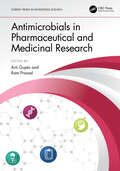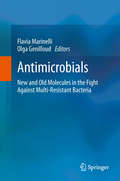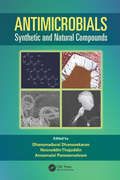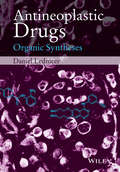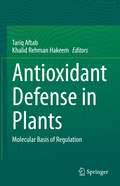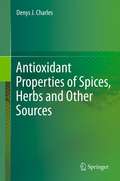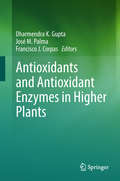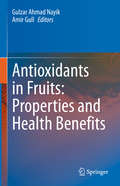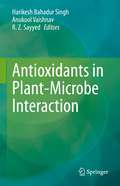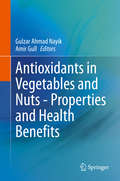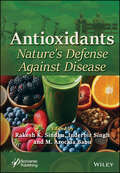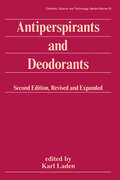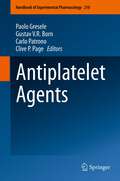- Table View
- List View
Antimicrobial Resistance: Global Challenges and Future Interventions
by Sabu ThomasAntimicrobial resistance is a major global public health problem. This book focuses on the clinical implications of multi-drug resistant pathogens; tracking AMR and its evolutionary significance; antifungal resistance; and current and alternative treatment strategies for AMR, including antivirulent, antibiofilm and antimicrobial resistance breakers, repurposing of drugs, and probiotic therapy. Advances in antimicrobial stewardship, antibiotic policies from a global perspective and their impacts are also discussed. The book also explores the use of omics approaches to gain insights into antibacterial resistance, and includes chapters on the potential benefits of a ‘One Health approach’ describing the environmental and zoonotic sources of resistant genes and their effects on the global resistance pool.
Antimicrobial Resistance: Omics and Systems Biology Approaches
by Vijay Soni Ajay Suresh AkhadeAntimicrobial resistance (AMR) is increasing globally at an incredible rate, and many infectious diseases have already reached an alarming stage of resistance to existing treatments. WHO reports that nearly1.27 million people currently die each year due to resistant infections, and AMR is projected to account for 10 million annual deaths globally by 2050. There is an urgent need for novel approaches to address this issue. Omics technologies are powerful research tools used extensively to study pathogen biology and the activity of microbial agents. These tools, paired with systems biology approaches, can provide novel insights into antimicrobial susceptibility and resistance, and aid in the development of new, more effective measures to combat resistant pathogens. This book provides a comprehensive overview of omics technologies to study pathogen biology, including proteomics, genomics, transcriptomics, metabolomics, and microbiome analysis, and the role of systems biology in developing strategies to combat resistant pathogens. It addresses environmental reservoirs and mobile genetic agents in AMR, host-pathogen interactions and physiology in the development of resistance, drug repurposing and development, and cutting-edge tools such as machine learning, AI for big data analysis, and genomic surveillance. The final section discusses future perspectives on omics-systems biology in AMR, and identifies opportunities for scientific collaboration in the global fight against antimicrobial resistance. This book serves as a comprehensive and accessible resource for researchers in academia and industry focused on immunology, drug development, biotechnology, and systems biology.
Antimicrobial Resistance: Underlying Mechanisms and Therapeutic Approaches
by Vinay Kumar Varsha Shriram Atish Paul Mansee ThakurAntimicrobial resistance (AMR) is a global public health threat that needs immediate attention and action from the scientific community. This book compiles and presents the latest and most important aspects of AMR, including the biology involved, its persistence and spread, and novel approaches to tackle this threat. The book first describes the mechanisms and spread of AMR, and then discusses the various approaches and strategies for combating it. Important topics include, microbial pathogenesis, AMR traits and major mechanisms underlying drug-resistance and the emerging strategies and technologies for combating AMR. Emphasis has been given on current developments about natural products including potent phyto-molecules, antimicrobial peptides and endophytes effective against the drug-resistant microbes and target the main drug-resistance determinants (efflux pumps, biofilms, quorum sensing, plasmids, etc.) in these bacterial pathogens. Other exciting topics include applications of nanomaterials in tackling AMR and CRISPR-Cas based precise sequence-specific antimicrobials. This informative book is meant for students and researchers in basic and medical microbiology and biotechnology. It is also useful to public health professionals and industry experts involved in AMR research and related drug-designing.
Antimicrobial Resistance: Workshop Report
by Forum on Emerging InfectionsAntibiotic resistance is neither a surprising nor a new phenomenon. It is an increasingly worrisome situation, however, because resistance is growing and accelerating while the world's tools for combating it decrease in power and number. In addition, the cost of the problem--especially of multidrug resistance--in terms of money, mortality, and disability are also rising. This book summarizes a workshop on antimicrobial resistance held by the Forum on Emerging Infections. The goal of the Forum on Emerging Infections is to provide an opportunity for representatives of academia, industry, government, and professional and interest groups to examine and discuss scientific and policy dilemmas of common interest that are specifically related to research on and the prevention, detection, and management of emerging infections. Organized as a topic-by-topic synthesis of presentations and exchanges during the workshop, the book highlights lessons learned, delineates a range of pivotal issues and the problems they raise, and proposes some simplified ideas about possible responses.
Antimicrobial Stewardship for Nursing Practice
by Heather Kennedy Briette Du Toit Yolanda Van Zyl Maria Clara Padoveze Ligia Maria Abraão Rosely Moralez Figueiredo Jo McEwen Nykoma Hamilton Emma Burnett Valerie Ness Fiona Gotterson Prof Elizabeth Manias Rose Gallagher Rita Olans Susie Singleton Joanne BosanquetDrug-resistant infections are one of the greatest threats to human health, and with resistance on the rise, appropriate antimicrobial stewardship (AMS) is more important than ever. This book, written by nurses for nurses, provides a clear and concise approach to good practice in this vital area. Exploring all aspects of AMS, this new book is underpinned by a competency framework endorsed by scientific and professional societies, including the National Institute for Health and Care Excellence (NICE). It explains the practices that ensure optimal use of antibiotics for the best clinical outcome, with both minimal toxicity to the patient and minimal impact on subsequent antimicrobial resistance. This book, the first applied directly to antimicrobial stewardship for nurses, supports standards of proficiency for registered nurses, and can therefore be used by regulators and professional bodies to inform standards of proficiency and guidance. The book covers infection prevention and control, antimicrobial resistance, diagnosis of infection and appropriate antimicrobial use, patient engagement, collaboration between professions and how to implement AMS in nursing practice. Including learning tools such as objectives, practical case studies and questions throughout, as well as lecture slides, this book is an essential read for undergraduate nursing students and specialist nurses worldwide. This book is authored by a multi-national group of experts with representation from professional associations, universities and national public health agencies, such as: - Royal College of Nursing, UK - Cardiff University, UK - University of São Paulo, Brazil - Public Health England, UK - National Centre for Antimicrobial Stewardship, Australia
Antimicrobial Susceptibility Testing Protocols
by Richard Schwalbe Lynn Steele-Moore Avery C. GoodwinThe clinical microbiology laboratory is often a sentinel for the detection of drug resistant strains of microorganisms. Standardized protocols require continual scrutiny to detect emerging phenotypic resistance patterns. The timely notification of clinicians with susceptibility results can initiate the alteration of antimicrobial chemotherapy and
Antimicrobial and Antiviral Materials: Polymers, Metals, Ceramics, and Applications
by Suchart Siengchin Sanjay Mavinkere Rangappa Peerawatt Nunthavarawong Mathew Thoppil-MathewEmerging microbial and viral infections are a serious challenge to health, safety, and economics around the world. Antimicrobial and antiviral technologies are needed to disrupt the progression and replication of bacteria and viruses and to counter their rapidly evolving resistance. This book discusses recent developments in materials science and engineering in combating infectious diseases and explores advances in antimicrobial and antiviral materials, including polymers, metals, and ceramics and their applications in the fight against pathogens. Features • Covers progress in biomimetic antimicrobial and antiviral materials and antimicrobial/antiviral bulk materials and coatings • Describes modern methods for disinfection of biomedical materials against microbial and viral infection resistance, especially for depressing novel coronavirus (COVID-19) • Details methods to improve material properties to have a longer service life in combating infection • Emphasizes chemical, physical, mechanical, tribological, and antimicrobial/antiviral properties • Offers current and future applications of emerging antimicrobial/antiviral technologies This book will be of interest to materials researchers and industry professionals focusing on antimicrobial and antiviral applications.
Antimicrobials in Agriculture (Current Trends in Antimicrobial Research)
by Ram Prasad Arti GuptaThis book offers comprehensive coverage of all manifestations of resistance in combating infectious diseases and explores advances in antimicrobials in agriculture and their applications in the fight against microbes. According to the World Health Organization, antimicrobial resistance is a major threat to global health because the number of alternative antibiotics is very limited. Antimicrobial resistance is a slow, evolutionary process that has been accelerated by human activities in the health, environment, and agriculture sectors. Due to their wide application, antibiotics and their residues have been found in almost all food products and natural ecosystems. This book appraises the drivers, impact, and mitigation of antimicrobials, with a focus on methods and targets. In addition, it also provides a variety of photographs, diagrams, and tables to help illustrate the material. The novel strategies to combat antimicrobial resistance are also described, emphasizing collaborative measures of control. The underlying molecular mechanisms, which depend not only on the microbe but on the specific drug molecule, are highly diverse and are covered in detail.Students, researchers, scientists, practitioners, academicians, biologists, microbiologists, stakeholders, and policymakers can benefit from current trends in antimicrobials in agriculture that address microbiology, microbial biotechnology, ethnopharmacology, toxicology, natural medicinal plant products, secondary metabolites, and all disciplines related to antimicrobial research.Features of the book: Covers antimicrobials in agriculture with up-to-date research Recent references on plausible antimicrobials in agriculture Public health impact of the use of antibiotics in agriculture Antimicrobial efficacy of medicinal plants Role of phytoalexins in agriculture Nanoparticles as antimicrobial agents Presents cutting-edge research on microbiology, nanotechnology, and emergent antimicrobial technologies
Antimicrobials in Environment (Current Trends in Antimicrobial Research)
by Arti Gupta and Ram PrasadThis book provides a multidisciplinary coverage of all manifestations of antimicrobials and antimicrobial resistance technology to promote eco-friendly processes and techniques for environmental sustainability. It covers various aspects of the multidisciplinary framework, applying principles of microbiology, environmental toxicology, and chemistry to assess the human and ecological risks associated with exposure to antibiotics or antibiotic resistance genes that are environmental contaminants. In addition, it also provides a variety of photographs, diagrams, and tables to help illustrate the material. Bringing together contributions from researchers on different continents with expertise in antibiotic resistance in a range of diverse environmental sections, the book offers a detailed reflection on the paths that make antibiotic resistance a global threat, and the state-of-the-art in antibiotic resistance surveillance and risk assessment in complex environmental conditions.Students, researchers, scientists, environmentalists, academics, computational biologists, stakeholders, and policymakers can benefit from using Antimicrobials in Environment as a resource that addresses microbial biotechnology, microbiology, toxicology, and all disciplines related to antimicrobial research.Features of the book: Covers antimicrobial resistance in the environment with up-to-date research. Includes recent references on each plausible antimicrobial resistance in the environment. Details the possible spread of antibiotic-resistant bacteria from an ecosystem. Describes the public health impact of the use of antibiotics in the environment. Presents cutting-edge research on nanotechnology, especially in food packaging, and emergent antimicrobial technologies. Highlights the antibiotic resistance in the environment: challenges and outlook.
Antimicrobials in Food Science and Technology (Current Trends in Antimicrobial Research)
by Arti Gupta and Ram PrasadThe demands of producing high-quality, pathogen-free food rely increasingly on natural sources of antimicrobials to inhibit food spoilage organisms, foodborne pathogens, and toxins. The recent developments and innovations of new antimicrobials from natural sources for a wide range of applications require that knowledge of traditional sources for food antimicrobials is combined with the latest technologies in identification, characterization, and applications. This book explores novel, natural sources of antimicrobials as well as the latest developments in using well-known antimicrobials in food, covering antimicrobials derived from microbial sources, animal-derived products, plants, and value-added products. This book includes the development and use of natural antimicrobials for processed and fresh food products. New and emerging technologies concerning antimicrobials are also discussed. This bookconsiders recent developments and innovations in food technology in combating infectious diseases and explores advances in antimicrobial constituents and their applications in the fight against microbes. In addition, it also provides a variety of photographs, diagrams, and tables to help illustrate the material. The novel strategies to combat antimicrobial resistance are also described, emphasizing collaborative measures of control. Advanced topics in the volume include food processing, food security, preservation, nutritional analysis, quality control, and maintenance as well as good manufacturing practices in the food industries. Students, research scientists, academicians, and policy makers can benefit from Antimicrobials in Food Science and Technology as a resource that addresses microbial biotechnology, food microbiology, fermentation technology, ethnopharmacology, toxicology, microbial/medicinal plant products, and all disciplines related to antimicrobial research. Features of the book: Covers all food antimicrobials, natural and synthetic, with up-to-date research on each type Recent references on every conceivable food antimicrobial Describes recent laws and regulatory guidelines in the selection of appropriate additives for specific food products Includes innovations in natural antimicrobial value-added products Offers current and future applications of emergent antimicrobial technologies and the use of multifactorial food preservation with antimicrobials Details methods to improve antimicrobial properties to have a longer service life in combating infection
Antimicrobials in Livestock 1: A European Perspective
by Lucie PokludováThis first volume in a two-volume work enhances readers’ understanding of antimicrobial resistance mechanisms in selected bacterial species that cause diseases in major food producing animals. It provides an overview of the current legislation and policies seeking to regulate the authorisation, manufacturing, distribution and use of veterinary antimicrobials in practice in a way that helps to contain the spread of antimicrobial resistance. The focus is put on Europe, without neglecting the global context. Moreover, attention is paid to various uses of antimicrobials in livestock, considering both their risks and benefits, from the distant past to the present. Growth promotion, prophylaxis, metaphylaxis, diagnostics and treatment are discussed not only with regard to food production and animal health, but also considering the One Health concept, which combines public and animal health with environmental aspects. A summary of various systems for monitoring the use of antimicrobials is provided, as well as an overview of the diseases that European veterinarians most often treat with antimicrobials. In closing, the book addresses the complexity of recent measures that are of key importance for antimicrobial stewardship, e.g. biosecurity, vaccination and other preventive tools including the newest technologies like smart farming. The complete two-volume work provides an extensive review of various aspects related to the use of antimicrobials in veterinary medicine, especially considering major food producing species, their most common infectious diseases and causative pathogens, and mainly focusing on the situation in Europe, without ignoring the global context. While Volume I discusses more general aspects of antibiotic use such as regulatory, laboratory and practical issues from different perspectives, Volume II more specifically discusses medical aspects and the use of antimicrobials in cattle, pigs, poultry and horses, as well as pharmacokinetics and pharmacodynamics, two of the most important factors determining the success of treatment. In both volumes, each chapter confronts the reader with open questions to stimulate further discussions and future research on the topics covered.
Antimicrobials in Livestock 2: A European Perspective
by Lucie PokludováThis second volume of the two-volumes work “Antimicrobials in Livestock” offers an in-depth look at the antimicrobials commonly used in veterinary medical care of the major food producing animals pigs, poultry and cattle as well as horses, bringing to readers’ attention also pharmacokinetic and pharmacodynamic characteristics of these drugs. The individual chapters also provide a brief description of preventive tools as well as alternatives to conventional treatment options that could help minimise the use of antibiotics and combat the problems caused by increasing antimicrobial resistance. The focus is on Europe, without neglecting the global context. The complete two-volumes provide an extensive review of various aspects related to the use of antimicrobials in veterinary medicine. Volume I explores the use of antimicrobials in animals from the regulatory, practical as well scientific perspective and is targeted on EU policies and regulatory surroundings, providing also information on risks linked to the extensive use of antibiotics in livestock and highlighting importance of methods of laboratory testing for susceptibility and resistance, starting from phenotype tests and moving towards genetic analysis results providing molecular biology aspects. Each chapter confronts the reader with open questions to stimulate further discussions and future research on the topics covered. Volume II more specifically discusses medical aspects necessary for targeted, responsible, and evidence-based use of antimicrobials in cattle, pigs, poultry, and horses, as well as pharmacokinetics and pharmacodynamics as two of the most important factors necessary for proper dosing schedule setting of effective treatment. While the preface of the first volume started with questions, Volume II’s preface ends with them, having the intention to provoke more in depth and innovative thinking and might be the start of a new era, which is needed to keep antimicrobials working and available for the future generations both in human and veterinary medicine.
Antimicrobials in Pharmaceutical and Medicinal Research (Current Trends in Antimicrobial Research)
by Ram Prasad Arti GuptaThe need for state-of-the-art antimicrobial agents is greater than ever because of the development of multidrug resistance in communal pathogens, the rapid rise of new infections, and the potential for use of multidrug-resistant agents in biological protection. Although the need for novel antimicrobials is increasing, the development of such agents faces significant obstacles. Pharmaceutical research and development costs are estimated to be $400–$800 million per approved agent. The most important natural antimicrobial compounds derived from various plant sources containing a wide variety of secondary metabolites. With collected contributions from international subject experts, this volume focuses primarily on antimicrobials. This book deliberates recent developments in microbial science in combating infectious diseases and explores advances in antimicrobial constituents and their applications in the fight against bacteria. In addition, it also provides a variety of photographs, diagrams, and tables to help illustrate the material. The novel strategies to combat antimicrobial resistance are also described, emphasizing collaborative measures of control. We describe the concerted efforts undertaken by global communities to combat antimicrobial resistance in detail. The most efficient strategy could be a behavioural change towards indiscriminate consumption, usage, and prescription of antibiotics. Students, research scientists, academicians and policy makers can benefit from Antimicrobials in Pharmaceutical and Medicinal Research as a resource that addresses biotechnology, applied microbiology, healthcare/pharmaceutical products, medicinal plant products, and all disciplines related to antimicrobial research. Features of the book: Covers development in plant-based antimicrobials for sepsis management and progress; Describes modern approaches for phyto-nanoconjugates in combating multidrug resistance in biomedicine; Details methods to improve antimicrobial properties to have a longer service life in combating infection; Describe bacteriocins and plant metabolites as biotechnological tools in food, pharmaceuticals and therapeutics applications; Highlights natural antimicrobial therapeutic peptides; Offers current and future applications of emerging antimicrobial technologies.
Antimicrobials: New and Old Molecules in the Fight Against Multi-resistant Bacteria
by Flavia Marinelli and Olga GenilloudReports on the emergence and prevalence of resistant bacterial infections in hospitals and communities raise concerns that we may soon no longer be able to rely on antibiotics as a way to control infectious diseases. Effective medical care would require the constant introduction of novel antibiotics to keep up in the “arms race” with resistant pathogens.This book closely examines the latest developments in the field of antibacterial research and development. It starts with an overview of the growing prevalence of resistant Gram-positive and Gram-negative pathogens, including their various resistance mechanisms, prevalence, risk factors and therapeutic options. The focus then shifts to a comprehensive description of all major chemical classes with antibacterial properties, their chemistry, mode of action, and the generation of analogs; information that provides the basis for the design of improved molecules to defeat microbial infections and combat the emerging resistances. In closing, recently developed compounds already in clinical use, those in preclinical or first clinical studies, and a number of promising targets to be exploited in the discovery stage are discussed.
Antimicrobials: Synthetic and Natural Compounds
by Dharumadurai Dhanasekaran Nooruddin Thajuddin Annamalai PanneerselvamAntimicrobials: Synthetic and Natural Compounds summarizes the latest research regarding the possibilities of the most important natural antimicrobial compounds derived from various plant sources containing a wide variety of secondary metabolites. With collected contributions from international subject experts, it focuses primarily on natural produ
Antineoplastic Drugs
by Daniel LednicerThe past decade has seen a significant increase of research aimed at discovering new drugs for treating cancer, and the increasing number of new antineoplastic drugs approved by regulatory agencies reflects this. Until now, details on the synthesis of these newer agents have been scattered in various journals and in US and European patents. This timely volume deals with the organic chemistry involved in the synthesis of the agents found within antineoplastic drugs, including descriptions of the synthetic schemes for the preparation of over 200 compounds that have been granted non-proprietary names. Compounds are collected in chapters based on the mechanism of action rather than on their chemical structures. Each individual chapter is preceded by a brief description of that mechanism and includes detailed flow charts of the preparation of those compounds accompanied by discussions of the organic chemistry involved in each step. The first half of this volume is dedicated to the syntheses of established chemotherapy drugs. Kinase inhibitors occupy the following chapters with the largest single chapter dealing with the fifty compounds that inhibit tyrosine kinase. This class stands out since over twenty compounds in this group have been approved for treating patients; a rare track record compared to any other class of therapeutic agents. Antineoplastic Drugs: Organic Syntheses is written to appeal to organic and medicinal chemists in industry and academia. It is beneficial to those composing grant proposals for NCI and related organizations. The book is accessible to advanced undergraduates as well as graduates and researchers as well as those with a thorough grasp of organic chemistry.
Antioxidant Defense in Plants: Molecular Basis of Regulation
by Khalid Rehman Hakeem Tariq AftabThis edited book highlights the molecular basis of various enzymatic and non-enzymatic antioxidants, defense mechanisms and adaptation strategies employed by plants to avoid the stressful conditions. Special focus is given to gene expression, omics and other latest technologies such as CRISPR-Cas mediated genome editing applications for defense related studies in plants. Environmental stresses such as drought, salinity or floods etc. induce the generation of reactive oxygen species (ROS) which causes severe damage to cell membrane integrity by accelerating lipid peroxidation. To counteract the detrimental effect of ROS, plants are inherited with an intricate and vibrant antioxidant defense system, comprised of enzymatic (catalase, peroxidase, superoxide dismutase, glutathione reductase, glutathione S-transferase, guaiacol peroxidase, monodehydroascorbate reductase, dehydroascorbate reductase etc.), and non-enzymatic (glutathione, ascorbate, α-tocopherol, carotenoids, flavonoids etc.) antioxidants, which scavenge and/or reduce excess ROS and improve plant tolerance to various stresses. Stress tolerance in most crop plants is positively correlated with an efficient antioxidant system. Therefore, studying the efficiency of antioxidant defense systems in plants is necessary for facilitating the plant’s nature of adaptation against challenging environments. This book is of interest to teachers, researchers and academic experts. Also, the book serves as additional reading material for undergraduate and graduate students of biotechnology and molecular biology of plants.
Antioxidant Properties of Spices, Herbs and Other Sources
by Denys J. CharlesThe scientific world and modern society today is experiencing the dawning of an era of herbal medicine. Extensive research has shown that aromatic plants are important anti-inflammatory, antioxidant, anti aging and immune boosting delectable foods, with the magic and miracle to boost our immune system providing us with extended and an improved quality of life. Apart from making bland recipes into welcoming or interesting victories, herbs and spices have stirred the minds of the research community to look deeper into its active components from a functional perspective. It is essential to present the scientific and medicinal aspect of herbs and spices together with the analysis of constituents, its medicinal application, toxicology and its physiological effects. Herbs and spices with high levels of antioxidants are in great demand as they tend to promote health and prevent diseases naturally assuring increased safety and reliability for consumers. Herbs and spices are not only known for taste and flavor, but today research has opened up a new realm in which the antioxidant properties of these aromatic plants provide preservation for foods and health benefits for consumers who look forward to concrete scientific research to guide them further and explore herbal medicine. The aim of this book is to create awareness in society about the reliability of medicinal properties of certain herbs and spices through scientific and scholarly research.
Antioxidants and Antioxidant Enzymes in Higher Plants
by Francisco J. Corpas Dharmendra K. Gupta José M. PalmaThis book provides an overview of antioxidants and antioxidant enzymes and their role in the mechanisms of signaling and cellular tolerance under stress in plant systems. <P><P> Major reactive oxygen species (ROS)-scavenging/modulating enzymes include the superoxide dismutase (SOD) that dismutates O2 into H2O2, which is followed by the coordinated action of a set of enzymes including catalase (CAT), ascorbate peroxidase (APX), glutathione peroxidase (GPX) and peroxiredoxins (Prx) that remove H2O2. In addition to the ROS scavenging enzymes, a number of other enzymes are found in various subcellular compartments, which are involved in maintaining such redox homeostasis either by directly scavenging particular ROS and ROS-byproducts or by replenishing antioxidants. In that respect, these enzymes can be also considered antioxidants. Such enzymes include monodehydroascorbate reductase (MDAR), dehydroascorbate reductase (DHAR), glutathione reductase (GR), alternative oxidases (AOXs), peroxidases (PODs) and glutathione S-transferases (GSTs). Some non-enzymatic antioxidants, such as ascorbic acid (vitamin C), carotenes (provitamin A), tocopherols (vitamin E), and glutathione (GSH), work in concert with antioxidant enzymes to sustain an intracellular steady-state level of ROS that promotes plant growth, development, cell cycles and hormone signaling, and reinforces the responses to abiotic and biotic environmental stressors. <P> Offering a unique compilation of information on antioxidants and antioxidant enzymes, this is a valuable resource for advanced students and researchers working on plant biochemistry, physiology, biotechnology, and signaling in cell organelles, and those specializing in plant enzyme technology.
Antioxidants in Fruits: Properties and Health Benefits
by Gulzar Ahmad Nayik Amir GullThis book provides a comprehensive review of the antioxidant value of widely consumed fruits. Each chapter covers the botanical description, nutritional & health properties of these popular fruits. Fruits are one of the most important indicators of dietary quality and offer protective effects against several chronic diseases such as cardiovascular diseases, obesity, and various types of cancer. In order to effectively promote fruit consumption, it is necessary to know and understand the components of fruits. In addition to underscoring the importance of fruit consumption’s effects on human diet, the book addresses the characterization of the chemical compounds that are responsible for the antioxidant proprieties of various fruits.Given its scope, the book will be of interest to graduate and post-graduate students, research scholars, academics, pomologists and agricultural scientists alike. Those working in various fruit processing industries and other horticultural departments will also find the comprehensive information relevant to their work.
Antioxidants in Plant-Microbe Interaction
by Harikesh Bahadur Singh R. Z. Sayyed Anukool VaishnavThis edited book is focused on antioxidant compounds and their biosynthesis, up-regulation, mechanism of action for selective bioactivity, targeted role and the advancement of their bioactive potential during plant-microbe interaction and other stress conditions. This book also emphasizes on the role of antioxidants in recruiting beneficial microbes in plant surroundings. Antioxidants have multiple biological roles in plants especially in the signalling pathway. These compounds are secondary metabolites produced besides the primary biosynthetic pathway and are associated with growth and development. Besides they also have special role to play during oxidative stress produced via abiotic stimulants or pathogen attack. This understanding of the biosynthesis, signaling and function of antioxidant compounds in plants during stress condition is helpful in restoring plant ecosystem productivity and improve plant responses to a wide range of stress conditions. This book is a useful compilation for researchers and academicians in botany, plant physiology, plant biochemistry and stress physiology. Also the book serves as reading material for undergraduate and graduate students of environmental sciences, agricultural sciences and other plant science courses.
Antioxidants in Vegetables and Nuts - Properties and Health Benefits
by Gulzar Ahmad Nayik Amir GullThis book covers the nutritional and nutraceutical profiles of a wide range of popularly consumed vegetables and nuts. The first half of the book focuses on popular vegetables, and describes how higher vegetable consumption reduces the risk of diseases ranging from diabetes to osteoporosis, diseases of the gastrointestinal tract, cardiovascular diseases, autoimmune diseases and cancer. The book also includes an interesting section on the antioxidant potential of mushrooms. In turn, the second half discusses the nutritional value of various nuts. Nuts are nutrient-dense foods with complex matrices rich in unsaturated fats, high-quality protein, fiber, minerals, tocopherols, phytosterols and phenolics. The respective chapters illustrate how the consumption of nuts could ward off chronic diseases like hypertension, cancer, inflammation, oxidative stress, high blood pressure, coronary heart disease etc. In order to effectively promote vegetable and nut consumption, it is necessary to know and understand the nutritional and nutraceutical profiles of vegetables & nuts. Given its scope, the book will be of interest to students, researchers, food scientists, olericulturists, dietitians and agricultural scientists alike. Those working in the vegetable and nut processing industries, horticultural departments and other agricultural departments will also find the comprehensive information relevant to their work.
Antioxidants: Nature's Defense Against Disease
by Rakesh K. Sindhu Inderbir Singh M. Arockia BabuThis book provides a comprehensive exploration of the role antioxidants play in preventing and managing a variety of diseases and critically examines current research on the effects of nutritional antioxidants on specific disease states. Antioxidants: Nature’s Defense Against Disease investigates the complex relationship between oxidative stress and many health disorders, providing essential insights into the role of antioxidants in disease prevention. It investigates how oxidative stress, induced by an imbalance of free radicals and antioxidants in the body, leads to the development and progression of maladies ranging from cardiovascular disorders to neurological diseases. The book includes evidence-based ways for harnessing antioxidants from natural sources such as fruits, vegetables, and herbs to reduce the impact of oxidative damage and improve general health. The book presents the most recent scientific advances and clinical findings in antioxidant therapy. It is a comprehensive resource for healthcare professionals and researchers and covers everything from the molecular mechanisms that underpin oxidative stress to the protective benefits of antioxidants against chronic diseases. Through its interdisciplinary approach and practical insights, Antioxidants: Nature’s Defense Against Disease provides readers with the knowledge and tools they need to optimize antioxidant consumption, empowering them to control their health and lower their risk of severe diseases. Audience The core audiences for this book are nutritionists, dieticians, researchers, and graduate students in health sciences, and those interested in preventive healthcare, such as health, nutrition, fitness, and wellness enthusiasts, looking to deepen their understanding of implementing antioxidant strategies and improving lifestyle choices.
Antiperspirants and Deodorants (Cosmetic Science and Technology)
by Karl LadenProvides a review of the most recent advances in the science and technology of controlling odour and wetness. This edition includes two new chapters on antiperspirant and deodorant formulations; two new chapters on relevant patent technologies of recent years; discussions on the chemistry of aluminium/zirconium antiperspirant salts; and a modernize
Antiplatelet Agents (Handbook of Experimental Pharmacology #210)
by Clive P. Page Gustav V. Born Paolo Gresele Carlo PatronoAntiplatelet therapy is the cornerstone of treatment of ischemic cardiovascular disease and over the last few years spectacular advancements in this field have been recorded. This is the first comprehensive handbook entirely dedicated to all the aspects of antiplatelet therapy. The book is divided into three main sections, pathophysiology, pharmacology and therapy, for a total of 23 chapters. A large group of leading experts from different European countries and from the USA, both from academia and industry, have contributed to the book. Besides a detailed overview on the pharmacology and clinical applications of all the currently used or of the novel antiplatelet agents, innovative approaches (e.g. intracellular signalling as an antiplatelet target, small RNAs as platelet therapeutics, etc.) or unconventional aspects (e.g. pharmacologic modulation of the inflammatory action of platelets are also treated. The book is oriented to both basic investigators and to clinicians involved with research on platelet inhibition or with the clinical use of antiplatelet therapies.
